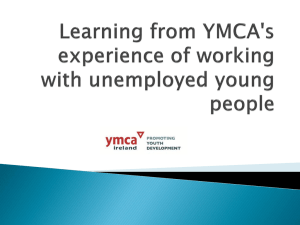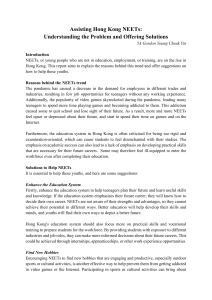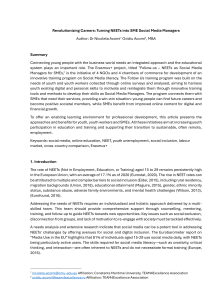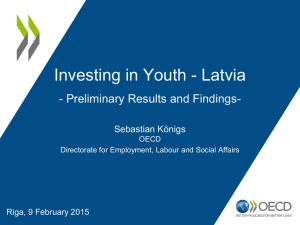5 - Developing a NEETs Based Library Service
advertisement
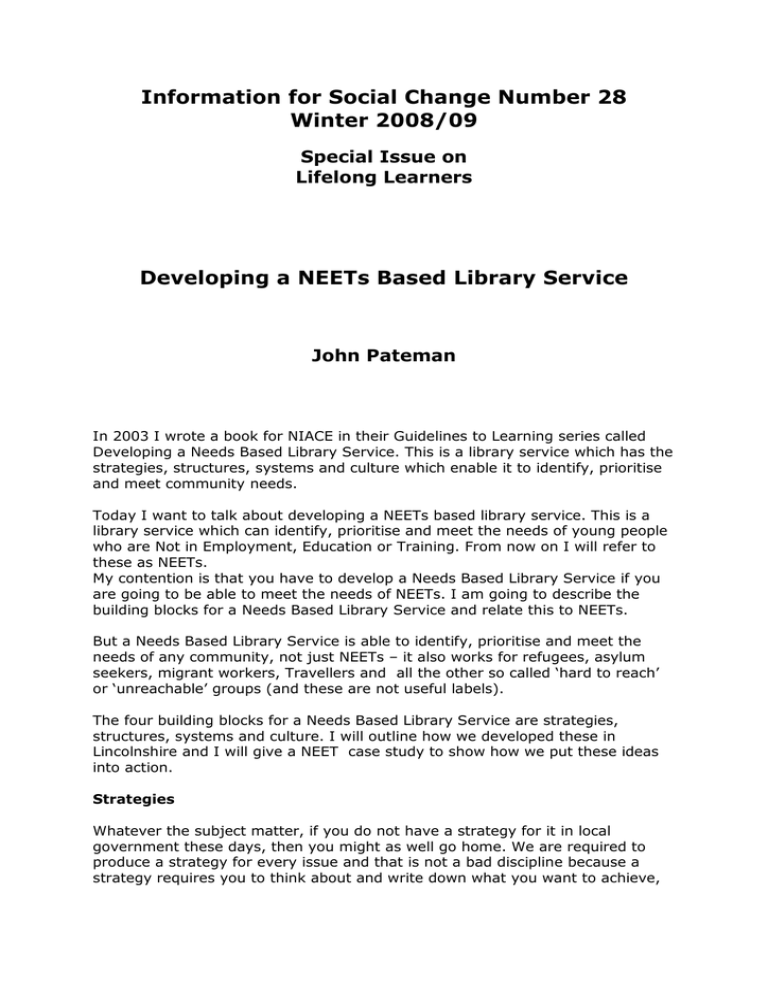
Information for Social Change Number 28 Winter 2008/09 Special Issue on Lifelong Learners Developing a NEETs Based Library Service John Pateman In 2003 I wrote a book for NIACE in their Guidelines to Learning series called Developing a Needs Based Library Service. This is a library service which has the strategies, structures, systems and culture which enable it to identify, prioritise and meet community needs. Today I want to talk about developing a NEETs based library service. This is a library service which can identify, prioritise and meet the needs of young people who are Not in Employment, Education or Training. From now on I will refer to these as NEETs. My contention is that you have to develop a Needs Based Library Service if you are going to be able to meet the needs of NEETs. I am going to describe the building blocks for a Needs Based Library Service and relate this to NEETs. But a Needs Based Library Service is able to identify, prioritise and meet the needs of any community, not just NEETs – it also works for refugees, asylum seekers, migrant workers, Travellers and all the other so called ‘hard to reach’ or ‘unreachable’ groups (and these are not useful labels). The four building blocks for a Needs Based Library Service are strategies, structures, systems and culture. I will outline how we developed these in Lincolnshire and I will give a NEET case study to show how we put these ideas into action. Strategies Whatever the subject matter, if you do not have a strategy for it in local government these days, then you might as well go home. We are required to produce a strategy for every issue and that is not a bad discipline because a strategy requires you to think about and write down what you want to achieve, how you are going to achieve it, and how you will know when you have achieved it. Strategy development should be an inclusive process and this is an effective way to engage stakeholders in what you are trying to achieve. In Lincolnshire our strategy for libraries was derived from the Sustainable Community Strategy produced by the Lincolnshire Assembly (our Local Strategic Partnership) and the County Council’s corporate objectives – Lifestyle, Excellence, Access, Diversity and Security (the acronym for which is LEADS). Our challenge was to convert these lofty aspirations and ambitions into meaningful words and activities. We did this by engaging with stakeholders including staff, service users and non users (which included NEETs). A series of focus groups (some exclusively for young people) created a strategy for the library service which was based on three key objectives – Inclusion, Learning and Regeneration. So NEETs were involved in the first stage of deciding the future direction and priorities of the library service. We then formed strategy development groups made up of a cross section of stakeholders (including NEETs) to discuss and determine what these objectives mean for local communities in terms of service delivery. These strategy development groups were self determining and selected their own leaders and ways of working, free of management control. Their task was to develop strategies which would enable public libraries in Lincolnshire to promote social inclusion, develop lifelong learning and regenerate local communities. And NEETs were asked to relate these strategic priorities to their own needs. These strategies were then aligned by senior management (which was our added value) to ensure that they were consistent and coherent across the Inclusion, Learning and Regeneration agendas. These strategies were then passed through the County Council’s decision making processes to ensure corporate and political buy in and commitment. This is vital because once a strategy has been approved it can be used to determine priorities and resource allocation. NEETs were involved in every stage of the strategy development process. Staff Structure NEETs were also involved in developing the second building block of a Needs Based Library Service – structures. Once you have developed a new strategy, you then need to review your structures – staffing structure and service structure – to check whether these structures are able to deliver the new strategy. In most cases the existing structures are no longer fit for purpose and have to be changed to align them with the new strategy. The staffing and service structures must enable the library service to deliver Inclusion, Learning and Regeneration outcomes and meet the needs of NEETs and other communities. In Lincolnshire this has led to the development of integrated staffing and service structures which combine the previously stand alone staffing and service structures of public libraries, museums (heritage) and adult learning. We have used the strategic objectives of Inclusion, Learning and Regeneration to bring these services together and break down professional silos and barriers. Through engagement with stakeholders (including staff and NEETs) job titles, job descriptions, person specifications and competencies were reviewed and changed to align them with the new strategic direction. A good example is my own job title - from being Head of Libraries I became Head of Libraries, Learning and Inclusion, which encompasses two of our strategic objectives (Learning and Inclusion). My fellow Head of Service leads on Heritage, Regeneration and Improvement, which covers the third strategic theme (Regeneration). All managers and staff went through a similar process of job redesign and we now have a management and staffing structure which has Inclusion, Learning and Regeneration running through it like the writing in a stick of seaside rock. Services to target groups (including NEETs) are reflected in every member of staff’s job description so that no one can say that meeting the needs of NEETs, for example, is ‘not my job’. As well as this generic approach to meeting needs, there is also a focus on target groups through the Access and Engagement Teams. For example, the Access Team act like detached youth workers and engage with NEETs where they hang out. Bus stops are a good place to meet people in Lincolnshire because buses can be few and far between which creates the opportunity for some meaningful engagement! After the Access Team has made initial contact with NEETs, the Engagement Team then works with them to identify activities which can engage them in library services. This often takes the form of a mini needs analysis so that the needs of NEET young people can be related to what libraries have to offer. These engagement activities are initially held in non library settings (such as youth clubs and village halls) but, over time, these activities are relocated into libraries. At this point, after NEET young people have crossed the threshold of the library, the responsibility for meeting their needs is passed over to front line staff – Cultural Services Assistants – who work with NEET young people to ensure that they get the full benefits of using the library service. Service Structure The service structure also needs to be aligned with the new strategy – this means looking at where libraries are located and seeking opportunities for colocation and partnership working to increase access to library services. In Lincolnshire our mantra is that the stand alone library is dead and we are only interested in development opportunities for our libraries which involve partnership working. One way of achieving this is for partners to move into the library and share space, services, staff and resources. For example, Crowland library is run in partnership with Crowland Cares, a community group; and Mablethorpe, Horncastle and Coningsby libraries are operated in partnership with District Council Community Access Points. Another form of partnership working involves library services being relocated into partner venues. For example, Belton Lane library is in a Children’s Centre and Branston library forms part of an extended school. The library service engages with NEETs in partnership with the Youth Service at Scotter Library (where we share staff and premises) and at the Earlsfield Youth Centre (where we provide ICT training). I would like to introduce our case study at this point because we engaged NEETs in the development of a new library at Boultham in the suburbs of Lincoln. The community profile for Boultham library indicated that young people made up a significant proportion of the catchment population of 8,000 people. This figure was projected to increase and the community profile also indicated that of the 14 Super Output Areas that exist within the catchment, 4 are ranked amongst the top 30% most deprived areas in England, with one amongst the top 10%. Also within the catchment area there is a Surestart Centre, a number of schools, a youth centre and an adult education centre. We worked in partnership with all of these agencies, and with the local Tenants and Residents Association, to develop the new library. The engagement of NEETs in the development of Boultham library was managed as part of our involvement in the national QLP-Y (Quality Leaders Program – Youth) program. The aim of this program is to develop library services and library staff by meeting the needs of local communities. This program is managed by London Metropolitan University and includes a range of local authorities including Portsmouth and the London Borough of Barnet. Lincolnshire was the only county council to take part in the program. I have bought along copies of QLP News and an article on the QLP-Y approach to staff development, if you want to find out more about QLP-Y. In Lincolnshire we selected two members of staff to take part in the QLP-Y program – one from the library service and one from the youth service. From the library service we chose a manager who had experience of working with excluded young people, including the Secure Unit for Young Offenders at Sleaford. From the youth service we chose the manager of the Entry to Employment program. E2E consists of individually designed learning packages which respond flexibly to meet learner’s needs and offer a range of provision including : basic skills; key skills; NVQ Level 1 or Level 2 units; vocational knowledge and skills; career awareness and management skills; employability skills including problem solving, effective thinking and team working; and work placements and tasters. By engaging with NEETs in the development of Boultham library the objectives of the QLP-Y project were to: encourage NEET young people to use the library service; encourage NEET young people to enter the E2E program. The initial meeting with Boultham’s NEETs took place in the local youth club and, with the young people’s consent, this meeting was recorded on DVD as evidence of our engagement with the local community. The DVD makes for lively viewing as our Quality Leaders explain what the project is about and get ideas from the young people about developing Boultham library. The NEETs suggested that the second planning meeting should take place in the existing Boultham library – a building which most of them admitted to never having visited before. It was useful to explore why they had not used the library and this helped to identify any potential barriers which might prevent young people from using the new library. The design of the existing library was one of the main barriers – it was old, ugly and off putting to young people. It looked very much like a municipal building and was often mistaken for public toilets. Inside it was dark, dinghy and musty with an assorted collection of old furniture and fittings. It was not untypical of many public libraries across the UK, which have suffered from lack of investment over a long period of time. Working with library staff, planners and architects the NEETs were given some real power and control over the planning and design of the new library. They had to be mindful of capital and revenue funding limits and so their ‘planning for real’ made them aware of the difficult choices which have to be made within finite resources. We were very impressed with the maturity which they bought to this task. The stereotypical view of young people is that they are all selfish, anti social hoodies who are only interested in themselves and do not care about the wider community. Our work with NEETs at Boultham library completely shattered these myths. Yes, they did want good quality services which met their specific needs, but they were also mindful of the needs of the whole community. As one young man put it ‘I want this library to be good for me and my friends, but I also want it to be good for my granddad and my little sister as well.’ And so these NEETs took an inclusive approach to developing their local library, and made compromises on what was spent on their own services to ensure that the needs of others were met. This was wholly consistent with our strategic objective to promote social inclusion. The new library was designed by NEETs to remove all of the barriers which were inherent in the old library. The new library is bright, attractive, colourful, open plan and uncluttered with plenty of natural light. The shelving is modern and mobile with face on display space, and the furniture includes low level coffee table book display spaces. The audio visual area is high tech with facilities for people to listen to recordings before they borrow them. There is also an ICT learning suite, a community meeting room, public toilets and drinks / snacks machine. None of these features are ground breaking and can be found in many new libraries across the UK, but the driving force for these changes at Boultham was NEET young people. The NEETs were also very keen that the library became a centre for all kinds of informal and formal learning, and they designed in a large number of People’s Network terminals plus the ICT learning suite. The People’s Network terminals enable informal learning and they are sited in a way which allows groups of users to gather around a single terminal, which is how NEET young people said that they preferred to engage with technology. They like to be able to interact with each other and the computer screen, which was not possible under the old ‘one user to each pc’ configuration. People’s Network users were encouraged to focus only on their own terminal and any movement of chairs was frowned upon. This has led to some redesign of all our libraries and associated staff training. The ICT suite provides a more formal learning environment and we work with a range of learning providers – commissioned via our Adult Learning Service – to run short courses at Boultham library. Some of these are programmed but many are on a drop in basis. NEETs have taken part in these courses which are designed to move them on to higher levels of learning. By designing formal and informal learning activities into Boultham library NEETs have helped us to meet our strategic objective of providing lifelong learning opportunities. Some of these NEETs have joined the Entry to Employment program and so libraries have helped to facilitate access to all three strands of the NEET agenda – Employment, Education and Training. The use of Boultham library has increased as a result of the improvements suggested by NEETs. The community meeting space is used by a wide range of local groups. The new library has given Boultham a boost and hope for the future. The library will help to support people through the coming recession. Our engagement with NEET’s has enabled libraries to deliver the strategic objective of community regeneration. Systems Moving onto the third building block of a Needs Based Library Service – Systems – these must also be consistent with the strategic objectives, staffing and service structures. Many of our traditional library systems create barriers to access and we need to remove these barriers if we are going to achieve our objectives of Inclusion, Learning and Regeneration. But first we have to identify these barriers and library staff are not in the best place to do this because they have worked with some of these systems for 150 years (the systems are that old, not the staff, but some staff seem to have been around that long!) NEETs are in a good position to identify barriers and potential barriers to accessing library services and it is an instructive experience to walk around a library with young people and ask them to point out the barriers. We did this at Boultham and the NEETs were very challenging about our existing practices and asked ‘Why do you do things like that?’ and ‘Why don’t you do it like this instead? Or ‘Why do you do it at all?’ They were aware that we needed to have certain rules and processes in place but they were against fines, charges, borrowing limits, issue periods and counters. They saw these as being barriers to library access and as being exclusive rather than inclusive in their impact. We are now using our strategic objectives of Learning, Regeneration and particularly Inclusion to persuade Members (who signed up to these objectives) that we need to change our systems to remove barriers to access. For example, each time we have reduced charges the use of our services has increased and it remains our aspiration and ambition to become the first public library service to abolish all fines and charges – watch this space. Although we were not able to immediately meet all the needs of NEETs in terms of changes to our systems, we did manage to pull off some quick wins, and one of these has had a far reaching positive impact on the whole of the library service. The NEETs at Boultham identified the large bureaucratic library counter with staff behind it as a major barrier and suggested that we replace this with a smaller staff pod and a self issue terminal. We took them up on this suggestion and Boultham was the first library where we piloted RFID (self issue and stock control technology). This pilot was successful and Members have agreed to invest £1.5m in capital funding to roll out RFID across the library network. Other library services have gone down this route but the driving force for RFID in Lincolnshire was NEET young people. Culture The fourth and most important building block in developing a Needs Based Library Service is organisational culture – the way we do things around here. The biggest challenge of a Needs Based Library Service is to realign the organisational culture with the strategic objectives, staffing and service structures and systems which deliver Inclusion, Learning and Regeneration. Changing the organisational culture is about changing attitudes and behaviours, hearts and minds. Engaging staff in the development of new strategies, structures and systems is the starting point for culture change. Involving staff in these processes in a meaningful way starts to shift attitudes and behaviour and helps them to own, control and understand the need for change. In Lincolnshire we have accelerated the culture change process via service planning, performance management, workforce development, positive action and partnership working. We have involved NEETs in staff recruitment and as volunteers to help change the culture. Language is the basis of culture and if you can change the language then you can shift the culture. Library staff no longer talk in terms of adult lending, children’s and reference services, but in terms of Inclusion, Learning and Regeneration services. Part of this culture change has been to actively involve local communities (including NEETs) in the planning, design, delivery and assessment of library services. So the NEETs at Boultham, as well as planning and designing the new library, have also been involved in the delivery and assessment of library services. Community engagement is a journey which should not end and we have worked with NEETs at every stage of that journey from planning and design through to delivery and assessment ,which in turn informs the next stage of planning and design. In conclusion, a Needs Based Library Service is one which can identify, prioritise and meet community needs, including those of NEETs. In order to achieve this you must develop strategies, structures, systems and a culture which enable you to identify, prioritise and meet community needs. A Needs Based Library Service can be summarised by using the words of a famous German philosopher who has come back into vogue during the current economic crisis, ‘from each according to their ability (in terms of library services) and to each according to their needs (in terms of local communities).’ If you adopt this approach to developing a Needs Based Library Service then you will enable your libraries to identify, prioritise and meet the needs of young people who are Not in Employment, Education or Training. John Pateman, Head of Libraries, Learning and Inclusion 01522 553207, john.pateman@lincolnshire.gov.uk
